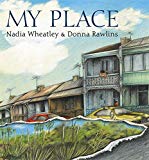My Place was first published in 1987, the year before the Australian Bicentenary, then republished in 2008 and 2018. It celebrates 30 years of lively and engaging moments in history that have relevance to children. The story focusses on one inner west Sydney street as seen through the eyes of the culturally diverse children who lived there. The narrative documents residents’ lives every ten years, over a 200 year period. The story opens in 1988 with ten-year-old Laura proudly pointing out the Koori flag in her window that ‘shows we’re on Aboriginal land … I think it means the colour of the earth back home’.
The detailed illustrations invite multilayered reading of historical detail including waves of migration, the effects of two world wars and visible deterioration in some homes after the Great Depression. Changing land use and the effects of urbanisation are reflected in the hand drawn maps, with children’s annotations. The constant geographical features are the big tree and the creek, gradually polluted then eventually developed into a canal.
Throughout the narrative the disruption of colonisation renders Laura’s people invisible. However, the 2008 timeline references the Mabo and Wik Judgements, recognising ‘Aboriginal people as the traditional owners of Australia’, highlighting ‘my place’ as home in 1788 for Barrangaroo, who reveals, ‘My grandmother says we’ve always belonged to this place. ‘But how long?’ I ask. ‘And how far?’ My grandmother says, ‘For ever and ever’.

